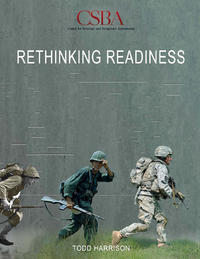
“DoD’s current method for resourcing readiness starts with the wrong metrics, lacks experimental data to isolate causal effects, and does not have a continuous feedback loop to update and refine readiness theories and models. The military could be significantly overfunding or underfunding readiness without knowing it.” - Todd Harrison, Strategic Studies Quarterly, Fall 2014 issue
The focus of this paper is how resources can be allocated most effectively to achieve the readiness required by one’s strategy. The two main challenges for DoD are developing readiness metrics that accurately measure the readiness of forces to perform the missions assigned to them and developing a better understanding of the causal relationships among readiness inputs and outputs.
Current readiness metrics focus almost entirely on inputs rather than outputs. The Status of Readiness and Training System (SORTS) aggregates and reports the readiness of individual units across the Services by comparing the levels of key inputs (personnel, equipment and supplies on hand, equipment condition, and training) to target amounts determined by the Services. The Department of Defense Readiness Reporting System (DRRS) incorporates SORTS metrics and includes a commander’s self-assessment of whether a unit is ready to perform the missions and tasks assigned to it. Congress also receives quarterly readiness reports from the military, and all of the reporting elements mandated in these reports relate to readiness inputs or the overall readiness ratings generated by SORTS and DRRS.
Readiness inputs are used as a proxy measure for the output—the ability of forces to perform the missions assigned to them. An implicit assumption in this approach is that the target levels of inputs set by the military are optimal to achieve the types and levels of readiness required by defense strategy. Reporting the status of readiness using inputs also creates a circular chain of logic when the readiness reporting system is used to justify a certain level of readiness inputs, but the readiness reporting system is merely a measurement of the inputs it is used to justify. By not reporting measures of readiness outputs—the ability of forces to perform the missions assigned to them—it is difficult for DoD to make a compelling case for readiness funding.
What the military needs is a “box score” for readiness—quantitative measures of the relevant performance attributes of forces. Each unit’s mission essential task list (METL) specifies the tasks it is expected to perform in support of the strategy. By measuring the ability of forces to perform assigned missions and tasks, one can link readiness metrics to strategy and measure outputs rather than inputs. Rather than reporting readiness inputs, like flying hours and maintenance levels, DoD should be reporting strategy-based output metrics, like average bomb miss distances.
Armed with strategy-based output metrics, one can begin to unravel the many causal relationships among readiness inputs and outputs. Such a process begins with the collection of strategy-based readiness metrics. Statistical analysis of this data can be used to identify correlations and form preliminary readiness theories and associated models. Historical data, however, merely record what happened under a particular set of circumstances. This data cannot reveal what would have happened had the inputs or circumstances been different. Other variables not being measured or controlled for—known as hidden conditionals—could be the actual cause of any observed correlation, and making it difficult to establish causal links among readiness inputs and outputs.
To establish a causal relationship, one needs randomized controlled experiments in which inputs are varied and the resulting outputs are measured. Using control groups is essential for understanding the counterfactual of what would have happened had the inputs not been changed, and randomization is important because randomly assigning units to the test and control groups helps isolate the effects of hidden conditionals that could bias the results. Using experiments to test readiness theories and models creates a self-correcting feedback loop to continually refine and update one’s understanding of readiness as technology, threats, operational concepts, and the military itself continue to change.
DoD’s current method for resourcing readiness starts with the wrong metrics, lacks experimental data to isolate causal effects, and does not have a continuous feedback loop to update and refine readiness theories and models. Without these important steps in the process, DoD is operating with significant blind spots when it resources readiness. The military could be significantly overfunding or underfunding readiness without knowing it.
The chief recommendation of this paper is that both DoD and Congress should revisit the way readiness is measured and resourced. DoD should develop strategy-based metrics based on existing mission essential task lists and report this data both internally and to Congress. For its part, Congress should amend the quarterly reporting requirements in Section 482 of Title 10 of the U.S. Code to include these strategy-based metrics. Each of the Services should also institutionalized the process of developing testable hypotheses, conducting controlled experiments to test these hypotheses, and using the results to continually refine readiness theories and models.
To be sure, better metrics and experimental data cannot compensate for a poor strategy, a force that is mismatched to the strategy, or resources that are insufficient to execute the strategy. A more effective allocation of resources, however, can give the United States a significant fiscal and military advantage by enabling it to afford a larger, better-trained force for a given level of resources or the same size force at a lower level of resources. Greater efficiency in the allocation of military resources can be a source of enduring strategic advantage.



























